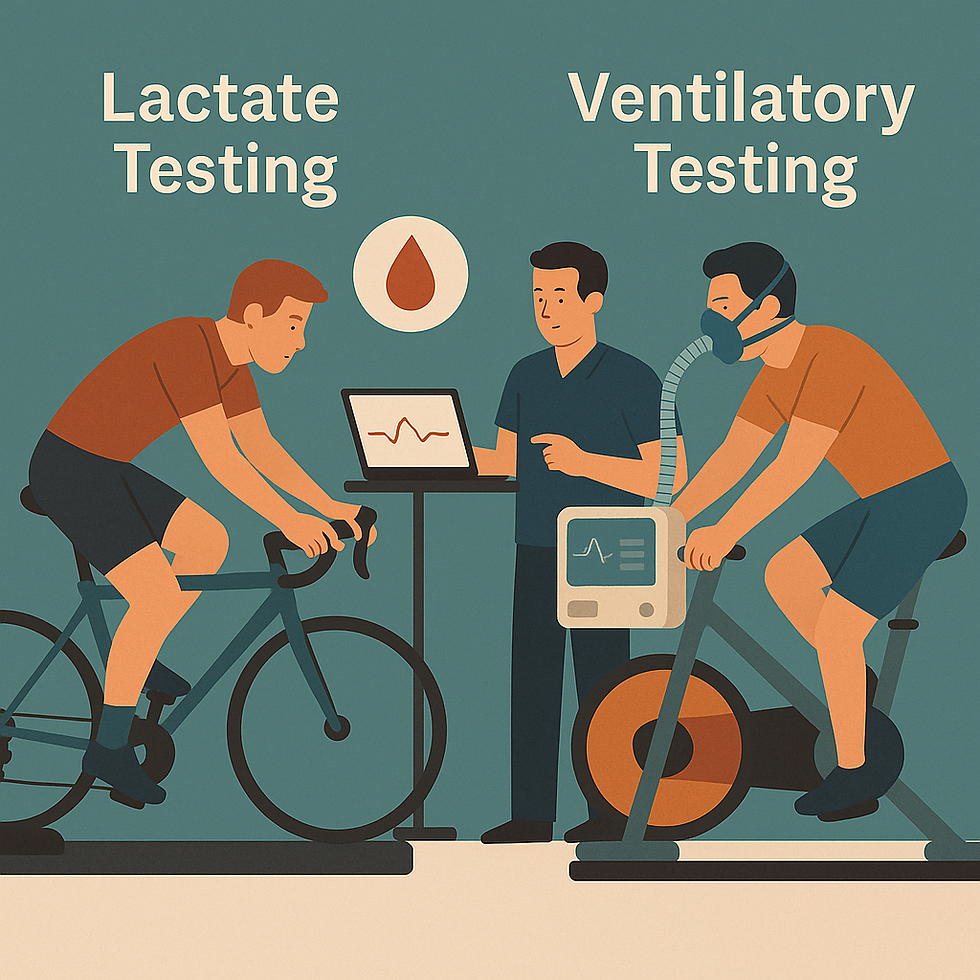Lactate thresholds vs. ventilatory thresholds: comparison of measurement protocols
- PAIRFS

- 3 days ago
- 3 min read
Why compare these protocols?
To determine training zones, coaches traditionally use:
lactate thresholds (LT1 and LT2), measured via blood tests,
ventilatory thresholds (VT1 and VT2), measured via respiration.
Although the two methods provide similar information, their protocols are very different , as are their accuracy, accessibility, and relevance in real-world conditions.
👉 This post compares the protocols point by point to understand their advantages and limitations.
1. Lactate test protocol: biochemical measurement
The lactate test consists of measuring the amount of lactate in the blood at each stage of exertion.
✔ Protocol Procedure
Warm-up 10–15 minutes
Start of the test on an ergocycle or treadmill
Stages of 3 to 4 minutes
At the end of each stage: a drop of blood is taken (ear or finger).
Lactate measurement (mmol/L)
Protocol progression until exhaustion
✔ What the protocol detects
LT1 : First point where lactate increases slightly
LT2 : 2nd point where acidosis rises rapidly
✔ Advantages
Direct physiological measurement
Method used in the laboratory for decades
Good detection of threshold 2 (LT2)
Scientific reference tool
✘ Limits
Invasive (multiple blood draws)
Long plateaus → less precise dynamics
Few measurements (one data point per level)
Sensitive to stress, nutrition (carbohydrates), and fatigue
Impossible to do outdoors or in real-world conditions
Expensive and non-transportable equipment
👉 The lactate test is accurate but cumbersome, invasive and difficult to repeat .
2. Ventilatory test protocol: dynamic measurement of respiration
Ventilatory thresholds are observed by analyzing:
ventilation (VE),
exhaled CO₂,
respiratory dynamics,
ventilatory stability.
✔ General procedure
The protocol depends on the hardware, but follows a similar logic:
Gradual warm-up
Start of the test on a home trainer, ergometer or road
Short stages or continuous progression
Continuous breath analysis (no mandatory stages)
Automatic detection of VT1 and VT2 via respiratory ruptures
✔ What the protocol detects
VT1 : lipid → carbohydrate switch
VT2 : onset of acidosis → hyperventilation
✔ Advantages
Non-invasive
Continuous and dynamic measurement
Huge data density → very high accuracy
Suitable for indoor and outdoor use
Very good detection of VT1 (sometimes difficult in lactate)
Repeatable every week
Portable and lightweight equipment (e.g., ZoneX)
✘ Limits
Requires a reliable and well-calibrated sensor
A poorly executed protocol can disrupt the transitions.
More sensitive to intentionally modified breathing (rare)
👉 The ventilatory test is the simplest, most reproducible and most accessible .
3. Comparison of protocols: point by point
Criteria | Lactate test | Ventilatory test |
Invasive? | Yes | No |
Continuous data? | No (1 measurement / level) | Yes (real-time data) |
Field representative? | No | Yes |
Test duration | 20–35 min | 8 to 25 minutes depending on the protocol |
VT1/LT1 Accuracy | Average | Excellent |
VT2/LT2 Accuracy | Excellent | Very good |
Reproducibility | Low (numerous external variables) | High |
Test frequency | Every 6–12 weeks | Every week if needed |
Cost / Materials | Moderate, portable | Raised, lab-grown... But made accessible with ZoneX |
Logistics | Average | Lightweight with ZoneX |
👉 To calibrate a training plan or track progress, the breathing protocol is far superior in practice.
4. Why are respiratory tests becoming the modern standard?
✔ 1. Easier to make
No blood, no lab, no complicated protocol.
✔ 2. More precise on metabolic dynamics
CO₂ is an extremely sensitive indicator.
✔ 3. Applicable in real-world conditions
Uphill, on a stationary trainer, on an endurance ride.
✔ 4. Very often reproducible
Ideal for following VT1 / VT2 every 2 weeks.
✔ 5. Scientifically correlated with lactate thresholds
VT1 ≈ LT1
VT2 ≈ LT2
👉 So we have the same information… but obtained more easily and more often.
5. ZoneX's advantage in this comparison
ZoneX allows:
a continuous analysis of CO₂
automatic detection of respiratory ruptures
a measurement in any environment
very high reproducibility
an automatic update of training zones
longitudinal monitoring of thresholds
🎯 Result: You get the same information as a lactate test… but without a lab, without a blood test, without the hassle.
Conclusion: two useful methods, but a clear winner for training
The lactate test
✔ precise
✘ rare
✘ invasive
✘ depending on the conditions
✘ Not very practical for the athlete
The breathing test
✔ precise
✔ Non-invasive
✔ easy
✔ frequent
✔ terrain
✔ dynamic
👉 To calibrate your zones and track your progress, the breathing protocol is the most reliable, modern and suitable method for real training .
👉 With ZoneX, this method becomes accessible to everyone, on every outing.




Comments